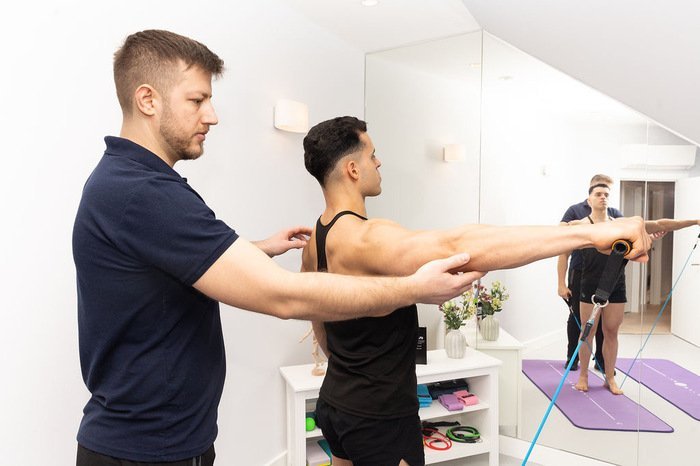Expert Physical Rehabilitation Techniques for Boosted Strength and Wellness
The domain name of professional physiotherapy encompasses a variety of strategies made to improve both stamina and overall well-being. Central to this technique is the understanding of customized treatment plans that incorporate resistance training, hands-on therapy, and functional workouts, each offering distinct roles in rehabilitation.
Recognizing Physical Rehabilitation Principles
Physical rehabilitation concepts are grounded in a holistic understanding of the body and its action to injury and rehabilitation. These concepts stress the interconnectedness of physical, emotional, and social factors that affect a person's health and wellness. A fundamental facet of physical rehabilitation entails examining the client's overall condition, recognizing disabilities, and developing tailored therapy plans that facilitate recuperation and improve feature.
At the core of physiotherapy is the idea in patient-centered care, where practitioners proactively involve individuals in their rehabilitation procedure. This collaborative technique fosters inspiration and encourages adherence to therapy protocols. In addition, physio therapists utilize evidence-based methods to direct their treatments, making sure that methods and methods are supported by existing research.
One more trick principle is the importance of activity and function in rehabilitation. Physio therapists concentrate on restoring wheelchair, strength, and sychronisation, recognizing that optimum physical function is important for overall health. In addition, education plays an important role in physical rehabilitation, as professionals overview clients in understanding their conditions and adopting much healthier way of living choices.
Secret Strategies for Strength Building
Toughness structure is a crucial part of rehab, aimed at enhancing muscular tissue feature and total physical efficiency. Physiotherapists employ numerous methods to facilitate this procedure, tailoring programs to meet specific client needs.
One trick method is resistance training, which involves workouts using weights, resistance bands, or body weight to increase muscular tissue stamina. This method effectively targets details muscle mass groups, advertising hypertrophy and endurance. Another vital technique is practical training, which concentrates on workouts that mimic day-to-day activities, enhancing the capability to perform regular tasks with better simplicity and toughness.
Modern overload is also essential in stamina structure. This principle entails progressively boosting the strength of workouts, whether through included weight, increased repeatings, or transformed tempo, ensuring regular adaptation and development of muscular tissue fibers. Furthermore, including plyometric exercises can improve power and explosiveness, which is especially beneficial for professional athletes and active individuals.
Last but not least, isometric exercises, where muscle mass agreement without changing length, can boost stability and stamina in details joints. By integrating these methods right into individualized rehab programs, physiotherapists can properly support individuals in achieving their strength-building goals, inevitably resulting in enhanced useful outcomes and enhanced high quality of life.
Advantages of Guidebook Therapy
Integrating a range of healing approaches improves the total performance of rehabilitation programs, try this and handbook treatment stands out as a useful strategy. This hands-on treatment contributes in minimizing discomfort, improving flexibility, and assisting in the recovery process.
Hand-operated therapy includes numerous methods, including soft tissue mobilization, joint adjustment, and myofascial launch (physio north lakes). These techniques aim to decrease muscle stress, enhance circulation, and restore useful motion. By attending to soft tissue restrictions and joint disorders, hands-on therapy can considerably add to discomfort alleviation and enhanced range of activity
Furthermore, the restorative touch involved in hand-operated therapy fosters a solid patient-provider connection, promoting trust and convenience. This emotional link can boost individual adherence to rehabilitation methods and general fulfillment with their care.
Study has demonstrated that guidebook treatment can be particularly reliable for conditions such as low neck and back pain, neck pain, and stress frustrations. physio north lakes. As a complementary therapy, it can be integrated with various other methods, such as workout or techniques, to optimize results. Ultimately, the advantages of hands-on treatment highlight its crucial function in comprehensive physical rehabilitation treatment plans, sustaining both stamina improvement and overall wellness
The Role of Workout Prescription
Workout prescription plays a critical duty in the rehab procedure, serving as a fundamental element for attaining optimal person outcomes. It includes the organized planning of physical tasks customized to the private demands and capabilities of individuals. By considering aspects such as age, physical condition, and certain wellness goals, physio therapists develop customized exercise programs that promote recuperation and enhance general physical health.

Additionally, workout prescription cultivates patient interaction and possession of the recovery procedure. By actively joining their healing, individuals are more likely to stick to recommended programs, causing boosted outcomes. In summary, exercise prescription is an essential element of physiotherapy, offering organized, personalized plans that support individuals in their journey toward enhanced strength and overall health.
Integrating Mindfulness in Recovery
The incorporation of mindfulness practices into rehabilitation strategies offers a holistic approach to recovery that enhances typical workout prescription. Mindfulness, specified as the deliberate concentrate on today moment, can considerably enhance patient end results by cultivating higher understanding of bodily sensations and moods. This heightened recognition enables individuals to much better identify pain signals and tension responses, facilitating extra reliable self-regulation.
Research study has revealed that incorporating mindfulness techniques, such as reflection and concentrated breathing, can decrease anxiety and improve psychological durability throughout recuperation. These methods encourage people to handle discomfort and grow a positive attitude, which is necessary for adhering to work out regimens and attaining long-lasting rehabilitation objectives.
Physiotherapists can include mindfulness by leading clients via short mindfulness exercises before or after physical therapy sessions. This assimilation not only help in physical healing but also advertises general mental health. Additionally, teaching individuals to participate in mindfulness during workouts can improve their emphasis, making sure that movements are executed with higher precision and objective.
Conclusion
